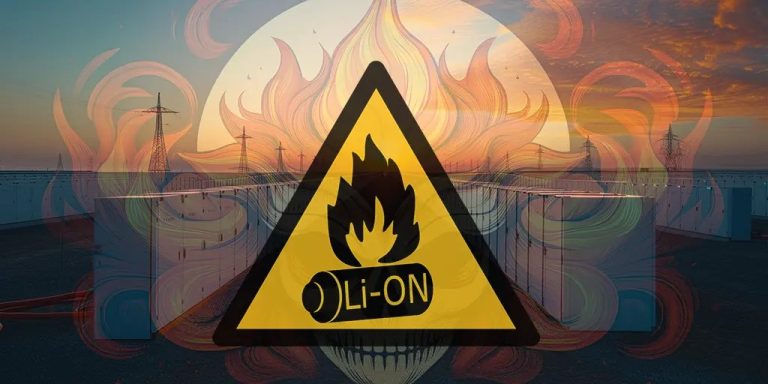from CFACT
David Wojik
The United States faces a growing threat from grid-scale lithium battery fires. Building huge battery arrays without considering the potential for catastrophic fires is out of control. There are no set standards to follow and local licensing authorities appear unaware of this very real danger.
Here is a brief introduction to this issue. First look at this photo of an existing grid array called “Desert Sunlight”: https://commons.m.wikimedia.org/wiki/File:Desert_Sunlight_(52290008686).jpg#file
These batteries are partnered with large solar facilities because, until recently, that was the only way to get subsidies for batteries. Each lithium battery cell is the size of a tractor-trailer or a large shipping container, numbering well over a hundred, and has a rated storage capacity of 230 megawatts. This is a medium-sized storage facility.
These devices are known to spontaneously ignite. The question is how to design and prepare for such a devastating event?
To solve this problem, consider the following events. Recently, a battery-powered tractor-trailer crashed on an interstate in California, destroying its battery. The lithium battery fire could not be extinguished, so the battery burned for about eleven hours. According to reports, firefighters sprayed 50,000 gallons of water during the process to prevent the fire from spreading and starting a wildfire. The interstate was closed due to toxic smoke from the fire.
One of these grid-scale battery cells is easily 10 to 20 times the size of a truck battery. The amount of water required to prevent the spread of a grid battery fire ranges from 500,000 to 1 million gallons of water. Actual quantities are engineering calculations that need to be established and incorporated into battery facility design standards.
Note that we're not talking about the spread of fires causing wildfires, although that is certainly a concern. The most important thing is to prevent it from igniting nearby batteries. If this happened, the entire facility could explode from the burning of a hundred or more giant batteries. That would be truly catastrophic.
Now look at the desert sun photo and notice there are no water tanks. There should be a million-gallon water tank and a high-capacity system to deliver water to every unit in the facility. Apparently not.
There is also an engineering issue as to how far apart the units should be to allow water to work to prevent the spread of fire. I doubt the desert sun is spaced far enough. There seemed to be only walking space between them.
Now let's turn to allowing these facilities, and I have another very telling example. This is a newly licensed Washington State facility. It is a joint wind, solar and battery project with a proposed storage capacity of 300 megawatts, much larger than Desert Sunlight's capacity. It probably has 200 huge lithium battery cells. The number has not been disclosed.
Although the project has a large number of solar and battery components, it is still named “Matiantang Wind Farm”. The name is often abbreviated to “Horse Paradise”, which is ironic indeed, as it will no longer be a habitat for horses. Horse hell might be better.
The permitting agency is the Washington Energy Facility Site Evaluation Commission (EFSEC). The license is called a Site Certification Agreement, or CSA, and Horse Heaven just received it after a strong push from the governor.
What is shocking is that the fire threat posed by this massive lithium battery facility is not discussed or even recognized. The CSA made numerous requests for issues large and small, even including facilities to provide water to reduce road dust. Having a million gallons or so of water will not prevent catastrophic fires or the environmental impact of such fires.
This is wildfire country, so liability insurance should be purchased for injuries caused to others by fires. Other potential sources of hazards include large amounts of contaminated water runoff and the emission of toxic air, especially if the entire facility burns.
This neglect undoubtedly stems from the Horse Paradise app. The app is over 500 pages long and I could only find one sentence about battery fires. In a long paragraph on page 366 of the PDF, we read that “Lithium-ion battery storage may pose a risk of fire and explosion due to the tendency of lithium-ion batteries to overheat.”
This sentence makes no mention of the project at all. For that matter, there are only a few paragraphs about the battery facility in the entire app, and most just describe it in general terms. There is no increase in the number of giant battery containers, nor does it indicate that it is a huge project in its own right, posing the same huge fire threat. In fact, the application states that they may double store these container-sized battery units, which is ridiculous given the risk of causing a chain reaction throughout the complex.
One could easily assume from the filing that batteries don't make any sense, and that seems to be exactly what happened with EFSEC.
This systemic neglect appears to be happening across the country. We urgently need a national code or standard that covers this issue. The National Fire Protection Association said it is working on an option, but implementation is up to permitting authorities.
The growing threat of grid-scale battery fires is a very serious issue that requires equally serious action.
Relevant
